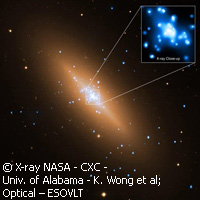X-ray images unlock mysteries of black holes
Scientists have been brought a step closer to understanding two of the biggest mysteries in astrophysics, thanks to new observations from the National Aeronautics and Space Administration (NASA) Chandra X-ray observatory; the space-based satellite launched by NASA in 1999 is capable of making observations with X-rays, something not possible within the Earth's X-ray absorbing atmosphere. These recent X-ray images show the flow of hot gas towards a black hole, and allow two fundamental problems in modern astrophysics to be tackled: understanding how black holes grow, and how matter behaves in their intense gravity. The scientists, from the Universities of Alabama, California, and Michigan in the United States, published the results of their study in the Astrophysical Journal Letters. The team analysed a black hole that is located about 32 million light years from Earth at the centre of a large galaxy known as NGC 3115. Although previous data has shown material falling towards and onto black holes, researchers have never before been able to see such a clear image of hot gas at various distances from the black hole. The imaging of the hot gas at different distances from this supermassive black hole allowed the astronomers to observe a critical threshold where the motion of gas first becomes dominated by the black hole's gravity and falls inward. This distance from the black hole is known as the Bondi radius. 'It's exciting to find such clear evidence for gas in the grip of a massive black hole,' said Ka-Wah Wong of the University of Alabama, lead researcher on the study. 'Chandra's resolving power provides a unique opportunity to understand more about how black holes capture material by studying this nearby object.' As gas flows towards a black hole, it becomes 'squeezed', which makes it get hotter and brighter. The team found that the rise in gas temperature begins about 700 light years from the black hole; they were then able to map the location of the Bondi radius. This suggests the black hole in the centre of NGC 3115 has a mass about two billion times that of the Sun, making it the closest black hole of that size to Earth. Data from the Chandra observatory also uncovers how the gas close to the black hole in the centre of the galaxy is denser than gas further out, as the team had predicted. Using the observed properties of the gas and theoretical assumptions, the team then estimated that each year gas weighing about 2% the mass of the sun is being pulled across the Bondi radius towards the black hole. 'A leading mystery in astrophysics is how the area around massive black holes can stay so dim, when there's so much fuel available to light up,' said co-author Jimmy Irwin, another researcher working on the study. 'This black hole is a poster child for this problem.' Two possible explanations for this discrepancy exist: firstly, that much less material actually falls onto the black hole than flows inside the Bondi radius; and secondly, that the conversion of energy into radiation is much less efficient than has been assumed. Different models describing the flow of material onto the black hole make differing predictions as to how quickly the density of the gas is seen to rise as it approaches the black hole. The team now hope that Chandra will yield more precise observations in the future, and provide astronomers with the data needed to rule out some of these models.For more information, please visit:NASA Chandra page:http://www.nasa.gov/chandra
Countries
United States



